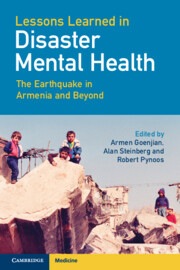Book contents
- Lessons Learned in Disaster Mental Health: The Earthquake in Armenia and Beyond
- Frontispiece
- Lessons Learned in Disaster Mental Health: The Earthquake in Armenia and Beyond
- Copyright page
- Contents
- Dedication
- Preface
- Contributors
- Chapter 1 The 1988 Spitak Earthquake in Armenia and the Implementation of the Psychiatric Outreach Program
- Chapter 2 Diaspora Therapists Working in the Earthquake Zone
- Chapter 3 Treatment Outcome among Early Adolescents Two Decades Post-Earthquake
- Chapter 4 Course and Predictors of PTSD and Depression among Not Treated Children and Adolescents over Two Decades
- Chapter 5 Conscience, Moral Injury, and Psychopathology
- Chapter 6 Natural Disasters and Relocation
- Chapter 7 Long-Term Course of PTSD and Depression Among Adults, Mediating and Moderating Factors in Recovery, and Current Trends for Treatment
- Chapter 8 How the Spitak Earthquake Contributed to our Understanding of the Genetics of PTSD and Associated Disorders
- Chapter 9 Epidemiology of Disasters and the Spitak Earthquake
- Chapter 10 Traumatic Stress Conceptual Framework
- Chapter 11 Memoirs of the Spitak Earthquake
- Chapter 12 Lessons Learned from the Spitak Earthquake and Other Catastrophic Disasters
- Index
- Plate Section (PDF Only)
- References
Chapter 12 - Lessons Learned from the Spitak Earthquake and Other Catastrophic Disasters
Published online by Cambridge University Press: 20 May 2022
- Lessons Learned in Disaster Mental Health: The Earthquake in Armenia and Beyond
- Frontispiece
- Lessons Learned in Disaster Mental Health: The Earthquake in Armenia and Beyond
- Copyright page
- Contents
- Dedication
- Preface
- Contributors
- Chapter 1 The 1988 Spitak Earthquake in Armenia and the Implementation of the Psychiatric Outreach Program
- Chapter 2 Diaspora Therapists Working in the Earthquake Zone
- Chapter 3 Treatment Outcome among Early Adolescents Two Decades Post-Earthquake
- Chapter 4 Course and Predictors of PTSD and Depression among Not Treated Children and Adolescents over Two Decades
- Chapter 5 Conscience, Moral Injury, and Psychopathology
- Chapter 6 Natural Disasters and Relocation
- Chapter 7 Long-Term Course of PTSD and Depression Among Adults, Mediating and Moderating Factors in Recovery, and Current Trends for Treatment
- Chapter 8 How the Spitak Earthquake Contributed to our Understanding of the Genetics of PTSD and Associated Disorders
- Chapter 9 Epidemiology of Disasters and the Spitak Earthquake
- Chapter 10 Traumatic Stress Conceptual Framework
- Chapter 11 Memoirs of the Spitak Earthquake
- Chapter 12 Lessons Learned from the Spitak Earthquake and Other Catastrophic Disasters
- Index
- Plate Section (PDF Only)
- References
Summary
This chapter summarizes the organizational and clinical lessons learned in implementing and conducting a post-disaster recovery program. It underscores the importance of a hierarchical approach with a centralized chain of command. This approach can facilitate recovery by mitigating adversities and removing roadblocks to community recovery. Supporting and empowering affected local governments and civil society, however incremental, plays a central role in extending assistance to underprivileged sectors. Likewise, working with the school hierarchy provides the necessary support to implement a school-based psychological intervention. Working with international donors and relief organizations should be a centralized “demand-driven” process rather than an “all aid is welcome” approach. Care for those with serious medical conditions, the displaced elderly, the homeless, and orphans should take priority over non-urgent mental health needs.
Before engaging with survivors, preparation of therapists for the hardships of fieldwork and providing support, supervision, and respite during fieldwork can minimize disabling reactions, e.g., vicarious traumatization and burn-out. Empowering mental health providers to take proper actions based on local socio-cultural norms rather than mechanically applying foreign knowledge can significantly improve the outcome of interventions. Most victims experience a combination of symptoms from different diagnostic categories, not only PTSD and depression but also grief reactions, substance abuse, and anxiety. Additionally, survivors have to contend with multiple adversities (e.g., loss of housing and jobs, financial problems) that will compound their psychological reactions. Effective therapists are flexible and adjust treatment according to the most pressing psychosocial needs of the survivors.
- Type
- Chapter
- Information
- Lessons Learned in Disaster Mental HealthThe Earthquake in Armenia and Beyond, pp. 193 - 208Publisher: Cambridge University PressPrint publication year: 2022



